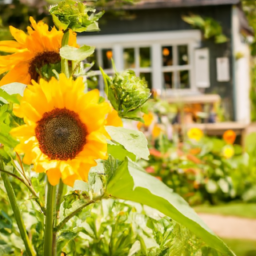Backyard Sunflower Garden Ideas
Backyard Sunflower Garden Ideas
Backyard Sunflower Garden Ideas
Types of Sunflowers
Sunflowers are a popular addition to many home gardens. There are many varieties of sunflower, each with its own unique characteristics. Some of the most popular types of sunflowers include the Black Magic, the Velvet Queen, the Sunrich Orange, and the Teddy Bear. Each of these types of sunflowers grow to different heights and sizes. The Black Magic sunflower grows up to 6 feet tall and has long, thin petals that turn dark as they mature. The Velvet Queen grows to a height of 3 feet and has dark red petals that turn reddish-purple as they mature. The Sunrich Orange sunflower grows to a height of 5 feet and has yellow petals. The Teddy Bear sunflower grows to a height of 4 feet and has bright yellow petals with a reddish center.
Sunflower Planting Techniques
When planting sunflowers, it is important to use the right technique for the soil and climate of your area. Sunflowers require direct sunshine for at least six hours each day, so they should be planted in areas that get plenty of direct sunlight. Loam or sandy soils are the best for planting sunflowers. For sandy soils, it is important to add plenty of organic matter, such as compost or manure, to help retain moisture and nutrients. For loam soils, do not add too much organic matter as this can cause the soil to become too dense for the sunflower roots.
Nutrition and Watering
Sunflowers need plenty of water and nutrition to grow and thrive. As they grow, they use a lot of nitrogen and phosphorus, so fertilize the soil with a fertilizer that is high in these nutrients. Water the sunflowers deeply but not often to make sure the soil stays moist throughout the plant's growth period.
Sunflower Garden Design
A sunflower garden can become a beautiful focal point in any garden. When designing your backyard sunflower garden, consider the type of sunflower you want to grow and the size of the garden. You can also choose to grow sunflowers in rows or create a sunflower patch. Sunflowers can also be grown in containers or as a border around other garden plants.
Pests and Diseases
Sunflower plants can be susceptible to certain pests and diseases. Common pests that target sunflowers include aphids, whiteflies, and mites. Aphids are small insects that suck the sap from the plant and can cause wilting and stunted growth. Whiteflies are small white flying insects that lay eggs on the undersides of leaves, causing clusters of white spots. Mites are spider-like pests that suck the sap from the plant and cause leaves to curl and yellow. To prevent or manage pests and diseases, make sure to practice good garden hygiene and keep plants free of dead leaves and debris.
Harvesting Sunflowers
Sunflowers are ready to be harvested when the back of the flower head turns yellow. Cut the stem about 6 inches below the flower head and hang it upside down in a cool, dark place to allow the seeds to dry for one to two weeks. Once the seeds are dried, remove them from the flower head and store them in an airtight container.
Insights
Growing a sunflower garden is a rewarding experience that can bring beauty and joy to any garden. To get the best results, it is important to choose the right type of sunflower for your climate, plant it appropriately, and provide proper nutrition and care. It is also important to monitor for pests and diseases and to harvest the flowers correctly to ensure the best production of seeds. With proper care and maintenance, sunflower gardens can be beautiful and productive additions to any garden.

Previous Page
Next Page
